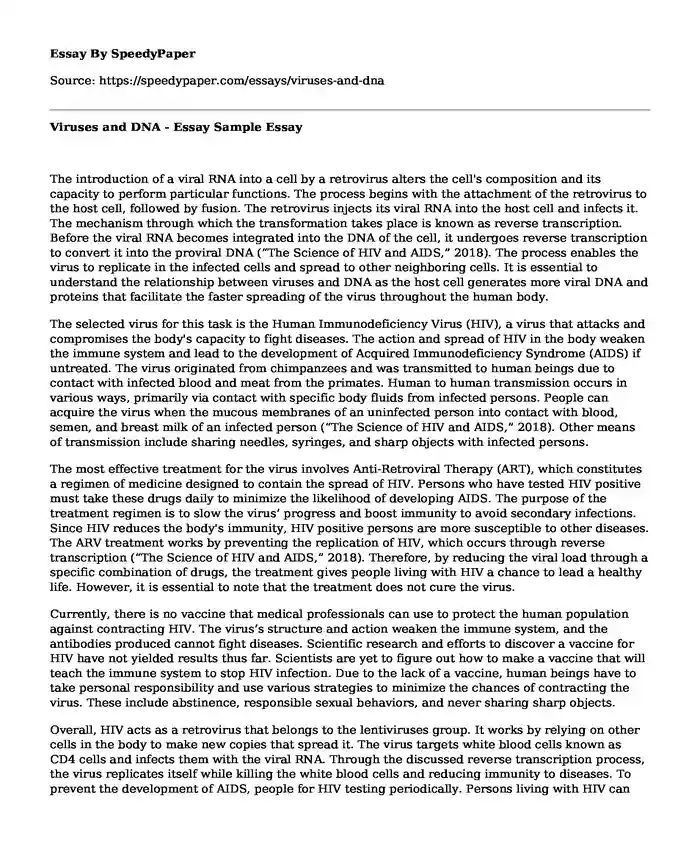
| Type of paper: | Essay |
| Categories: | Biology Medicine Healthcare |
| Pages: | 3 |
| Wordcount: | 668 words |
The introduction of a viral RNA into a cell by a retrovirus alters the cell's composition and its capacity to perform particular functions. The process begins with the attachment of the retrovirus to the host cell, followed by fusion. The retrovirus injects its viral RNA into the host cell and infects it. The mechanism through which the transformation takes place is known as reverse transcription. Before the viral RNA becomes integrated into the DNA of the cell, it undergoes reverse transcription to convert it into the proviral DNA (“The Science of HIV and AIDS,” 2018). The process enables the virus to replicate in the infected cells and spread to other neighboring cells. It is essential to understand the relationship between viruses and DNA as the host cell generates more viral DNA and proteins that facilitate the faster spreading of the virus throughout the human body.
The selected virus for this task is the Human Immunodeficiency Virus (HIV), a virus that attacks and compromises the body's capacity to fight diseases. The action and spread of HIV in the body weaken the immune system and lead to the development of Acquired Immunodeficiency Syndrome (AIDS) if untreated. The virus originated from chimpanzees and was transmitted to human beings due to contact with infected blood and meat from the primates. Human to human transmission occurs in various ways, primarily via contact with specific body fluids from infected persons. People can acquire the virus when the mucous membranes of an uninfected person into contact with blood, semen, and breast milk of an infected person (“The Science of HIV and AIDS,” 2018). Other means of transmission include sharing needles, syringes, and sharp objects with infected persons.
The most effective treatment for the virus involves Anti-Retroviral Therapy (ART), which constitutes a regimen of medicine designed to contain the spread of HIV. Persons who have tested HIV positive must take these drugs daily to minimize the likelihood of developing AIDS. The purpose of the treatment regimen is to slow the virus’ progress and boost immunity to avoid secondary infections. Since HIV reduces the body's immunity, HIV positive persons are more susceptible to other diseases. The ARV treatment works by preventing the replication of HIV, which occurs through reverse transcription (“The Science of HIV and AIDS,” 2018). Therefore, by reducing the viral load through a specific combination of drugs, the treatment gives people living with HIV a chance to lead a healthy life. However, it is essential to note that the treatment does not cure the virus.
Currently, there is no vaccine that medical professionals can use to protect the human population against contracting HIV. The virus’s structure and action weaken the immune system, and the antibodies produced cannot fight diseases. Scientific research and efforts to discover a vaccine for HIV have not yielded results thus far. Scientists are yet to figure out how to make a vaccine that will teach the immune system to stop HIV infection. Due to the lack of a vaccine, human beings have to take personal responsibility and use various strategies to minimize the chances of contracting the virus. These include abstinence, responsible sexual behaviors, and never sharing sharp objects.
Overall, HIV acts as a retrovirus that belongs to the lentiviruses group. It works by relying on other cells in the body to make new copies that spread it. The virus targets white blood cells known as CD4 cells and infects them with the viral RNA. Through the discussed reverse transcription process, the virus replicates itself while killing the white blood cells and reducing immunity to diseases. To prevent the development of AIDS, people for HIV testing periodically. Persons living with HIV can lead fulfilling and productive lives with the help of treatment regimens and adherence to medical guidelines. Despite the lack of a vaccine and cure, the virus does not signify a death sentence for infected persons.
References
The science of HIV and AIDS. (2018). Overview. Retrieved 11 August 2020, from https://www.avert.org/professionals/hiv-science/overview
Cite this page
Viruses and DNA - Essay Sample. (2023, Nov 12). Retrieved from https://speedypaper.com/essays/viruses-and-dna
Request Removal
If you are the original author of this essay and no longer wish to have it published on the SpeedyPaper website, please click below to request its removal:
- How Democratic was Jacksonian Democracy?
- Cultural Relativism Essay Example
- Free Essay with the Diet Analysis - MyNetDiary App
- Free Essay. Mental Health Problems Among Immigrants in the UK.
- Paper Example. Criminalistics SUB
- Essay Sample on Bill of Rights: Right to Privacy
- The Band Played On: Structuring the HIV/AIDS Outbreak Crisis - Essay Sample
Popular categories




